
Why we calculate percent changes in a strange way when calculating elasticities. Created by Sal Khan.
- Subject:
- Economics
- Social Science
- Material Type:
- Lesson
- Provider:
- Khan Academy
- Provider Set:
- Khan Academy
- Author:
- Sal Khan
- Date Added:
- 07/27/2021

Why we calculate percent changes in a strange way when calculating elasticities. Created by Sal Khan.
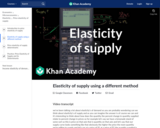
Thinking about elasticity of supply. Created by Sal Khan.

Total surplus is maximized in a market at equilibrium. In this video, we talk about why this is and the math behind this assertion.

In this video, Professor Don Boudreaux of George Mason University explains how the price system is able to coordinate the behavior of billions buyers and suppliers in a great chain of global cooperation.
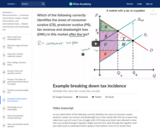
Tax incidence is a description of how the burden of a tax falls in a market. In this video we break down how to identify consumer surplus, producer surplus, tax revenue and tax incidence, and dead weight loss after a tax.

Context Rich Problem using the concepts of excise tax incidence, elasticity of demand, and elasticity of supply. Students must determine which information is appropriate and which is extraneous to the problem.

Trade benefits both buyers and sellers, but what happens when the transaction affects a third party? In this video, Professor Michael Munger of Duke University defines the term externality and explains different ways to solve the problem of externalities.
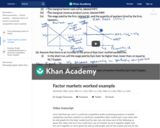
In this video, learn how to apply the analysis of factor markets to a sample problem.

Price changes the quantity supplied, but what might cause supply to increase even if price hasn't changed? In this video, we explore the determinants of supply: those factors that cause an entire supply curve to shift. Created by Sal Khan.

Explore how to think about average fixed, variable, and marginal costs, and how to calculate them, using a firm's production function and costs in this video. Created by Sal Khan.

According to Prof. Don Boudreaux of George Mason University, free trade is nothing more than a system of trade that treats foreign goods and services no differently than domestic goods and services. In this video, Professor Boudreaux defines free trade and protectionism and provides real world examples of free trade.
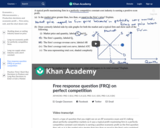
Walk through the solution to a free response question (FRQ) like the ones you may see on an AP Microeconomics exam. Topics include why price equals marginal revenue (P=MR) for a perfectly competitive firm, how to draw side-by-side market and firm graphs, and how to find several points of interest in the firm graph.
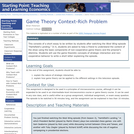
This consists of a short essay to be written by students after watching the West Wing episode "Hartsfield's Landing." In it, students are asked to help a friend to understand the content of the show using the basic components of non-cooperative game theory and the prisoner's dilemma.

We deepen our understanding of a Nash Equilibrium by exploring Pareto optimality and more on Nash Equilibrium. Created by Sal Khan.

Learn how the Gini coefficient can be used to interpret income inequality in this video.

See how changes in costs affect cost curves in this video.

This video shows how to graph marginal cost, average variable cost, and average total cost. The relationship between these curves at important points is also explored.

If you were a government official trying to raise revenue, who would you tax? Pick whether to tax cigarettes, luxury goods, or oil and gas in this interactive game and Professor Art Carden of Samford University will explain how the market will react.
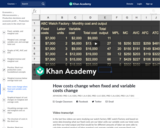
This video expands on previous videos to explore how changes in production technology, changes in fixed costs, and changes in variable costs affect the marginal product of labor, marginal costs, average variable costs, average fixed costs, and average total cost.

Given that hiring more workers gives more revenue, but also has additional cost, what is the optimal amount of labor to hire? We begin thinking about this as well as briefly discuss another type of competition: monopsony labor markets. Created by Sal Khan.